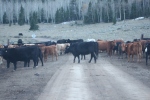Kirsten and I went up to the Fish Lake National Forest and camped on Thousand Lake Mountain in southern Utah for a couple of nights this last Thursday through Saturday August 16-18. This area is just north of Torrey and we like to get up there in the summer just to get out and to do a little volunteer assessment of the management practices on these public lands.
We came away glad to have been out but distressed at how the land is being over used particularly for grazing and logging. Working with Mary O’Brien of the Grand Canyon Trust we have become aware of how the open spaces of the public lands in the West are in a state of what Mary calls normalized degradation. I’m afraid she is right. The national forest above the Wasatch Front is managed for people. These dry desert mountains in southern Utah have a multiple use directive, but the use in fact is dominated by ranching. The contrasts are distinct. Wildflowers are hip deep all summer in the Wasatch. The southern meadows are grazed every year down to a 4″ stubble height. That’s the goal, it is usually worse. Riparian areas in particular take a beating. Because of pressure by environmentalists some small areas called “exclosures” have been set aside and somewhat protected from grazing. The ecological difference in these exclosures is tremendous. The cowboys obviously still let the cows into these protected spaces but not enough to erase the evidence of what these mountain meadows could be without public land grazing.
I have blogged about it more here and elsewhere, but the reasoning behind public land grazing defies common sense. It is not economic. The ranchers/livestock permittees depend heavily on subsidies for water, gates, fences, rangeland “treatments” and pasture control. Most of them make very little money all the same. Public land grazing is probably the number one source of public land degradation and yet the public subsidizes it. It is a story of a very narrow special interest taking advantage of the public’s clueless largesse. It has long been a problem and one that seems to be intractable. At $1.35 per AUM (Animal Unit Month – one cow and calf for a month of grazing) ranchers pay the same fee to graze as they did in 1966. Who gets such treatment today? One way out, the best one I can see, is to give ranchers a right they do not now have and allow them to accept grazing retirement buyouts. -Mark Bailey










































